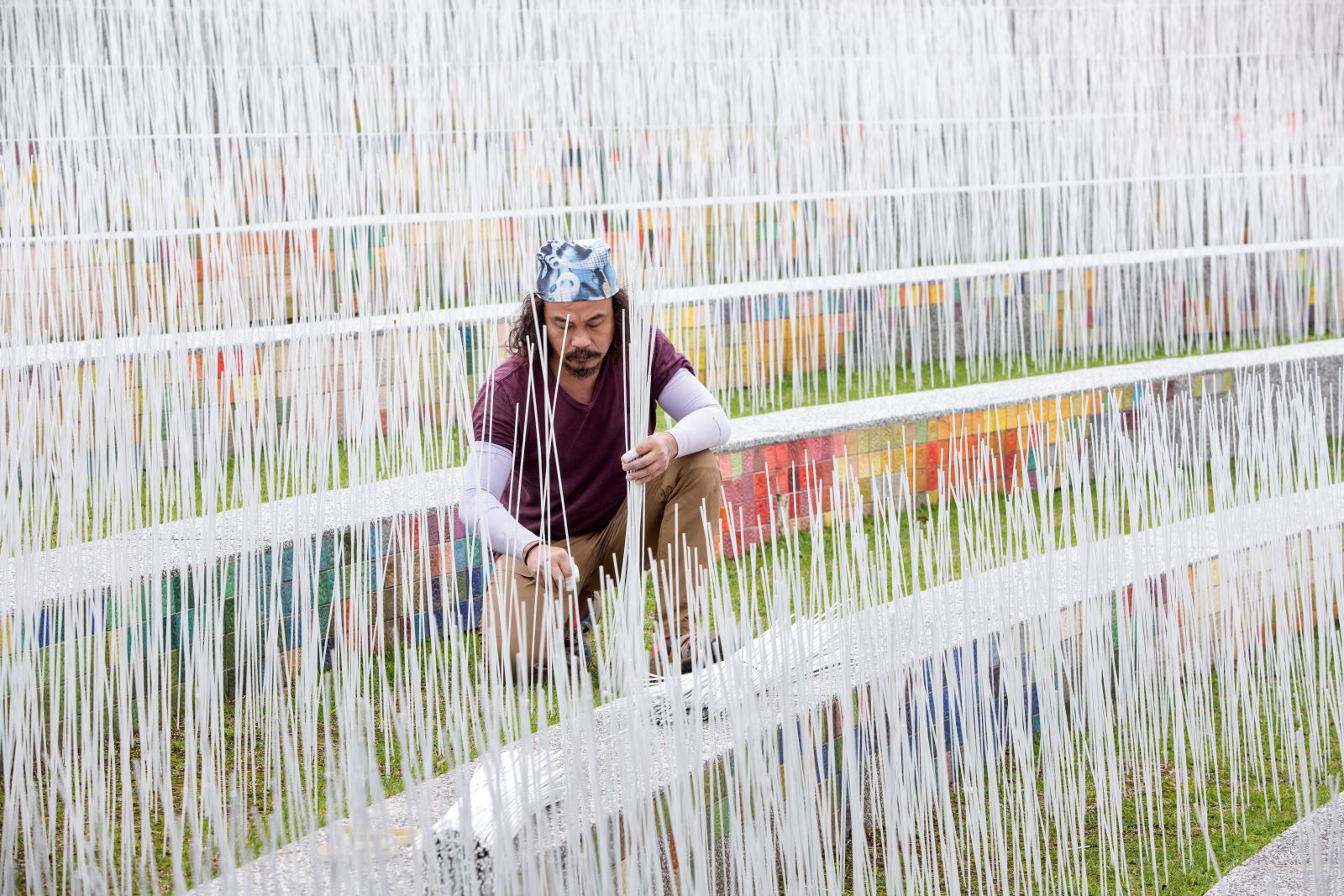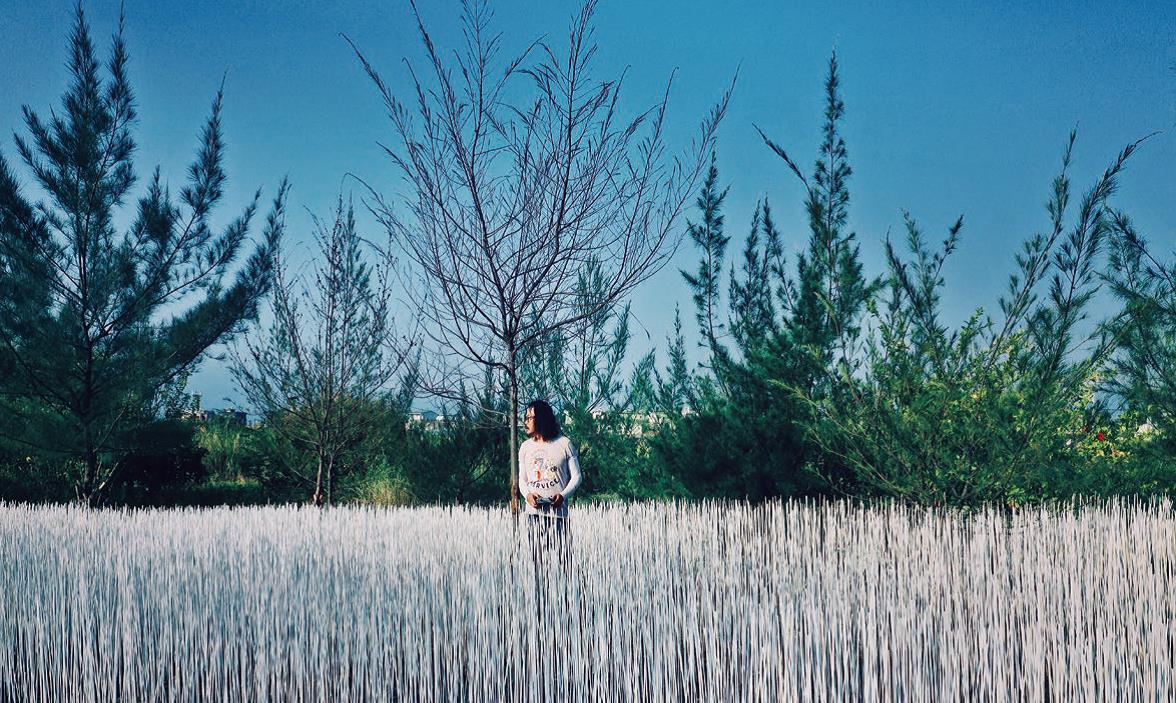
News
【Taiwan Hall Announcement】Snow in Summer: A Work of Land Art displayed in Taiwan Hakka Museum
- Source:客家文化發展中心
- Publication Date:2020/04/17
- Last updated:2020/10/15
- Count Views:1755

During the Hakka Tung Blossom Festival, artist Yu Wen-fu (游文富) displayed his sensational art installation at the Taiwan Hakka Museum in Miaoli from April 4 through May 24. Using white and pink bamboo sticks to cover the massive area, Yu was trying to present the imagery of April snow through a beautiful interpretation of Hakka vitality.
Yu often uses feathers and bamboo to create different types of art work, such as graphic art, space installations, and landscape art. For him, feathers and bamboo are not just materials for creation; they are also important elements in his life.

Yu had served in the Air Force and began art creation after leaving the military. His flying experience in military service profoundly inspired him to produce his creations with feathers. Through the light floating nature of feathers, the artist reflects the soft texture of clouds; and through the way feathers give to the touch and the way they move, he depicts wind, water, air or sound.
In 2001, the first-ever Penghu International Earth Art Festival was held. One of the artworks exhibited at the festival was an eye-catching creation by Yu, titled "Let the Mountain Fly (讓山飛行)." In this work, Yu inserted white feathers all along the top of a hill, creating what looks like a white winding hiking trail from a distance. Whenever a sea breeze blows, the 100-meter-long and 0.6-meter-wide installation art that sways with the breeze enables people to perceive the wind. Yu said: "The mountain can't fly, but when the wind blows at the mountain, the feathers are taken away by the wind, and the wind exists there."
In 2015, he completed the installation work "Hiding in the Clouds (雨云身朵)," using 200,000 feathers and 40,000 pieces of bamboo. Only the legs and feet of the person in the art work are exposed as they stand on the ground. The upper body is hidden in a cloud of feathers. With this creation, Yu wanted to show the hidden will and thoughts through the imagery of human bodies immersed in the clouds, while their feet stand firmly on the ground, symbolizing people’s practical and realistic side supporting their willpower to dream.
Yu grew up in Zhushan Township, Nantou County, where bamboo abounds (Zhushan literally means Bamboo Mountain). A bamboo art factory was run by his family. For him, "bamboo" is a familiar material. Based on his extensive knowledge of bamboo, he conveys through his bamboo works the passing of time, as well as his warm feelings for his hometown.

Yu’s "Changes of Bamboo (竹變系列)” installation work shows how bamboo develops moldy spots overtime when it’s exposed to warm temperature and humidity in the natural environment. Through this piece of art, the artist depicts changes in time and nature. He dyed the bamboo into different colors and treats the parts of the bamboo surface that has been changed by coming into contact with air to varying degrees, in order to control how quickly and how many mildew spots grow. The growth of mildew spots and the natural changes of the dyed bamboo over time make the work look like an organism that echoes the external environment.
In addition to the use of mildew, Yu also expresses the close connection between bamboo and the Taiwanese people’s daily lives through his large-scale bamboo work "Build (竹工凡木).” To make this work of art, Yu employed a total of 100,000 pieces of bamboo to weave a wall covering an area of 1,200 square meters that encompassed the entire Taipei Museum of Contemporary Art. Through this kind of creation, he illustrates the advantages of bamboo as a material for construction in the early years of Taiwan’s history and the intensive labor required for construction work.
Yu said that feathers are like ideas in his dreams, and bamboo represents his wish for returning to his roots. He uses these two media, which are closely linked to his experiences, to express different aspects of his life in his creations.
This spring, in the blooming season of Tung blossoms, a creative work by Yu Wen-fu adds a poetic touch to this Hakka village.
Snow in Summer: A Work of Land Art
Artist: Yu Wen-fu
Date: April 4 to May 24
Location: Taiwan Hakka Museum (6, Tongke S. Road, Jiouhu Village, Tongluo Township, Miaoli County)
